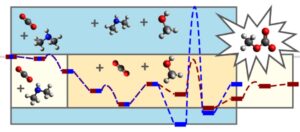Provision of Integrated Computational Approaches for Addressing New Market Goals for the Introduction of Safe-and-Sustainable-by-Design Chemicals and Materials
Latest PINK News
The integration of the SSbD Framework into the development cycle of AdMas&Chems will be achieved by solving the multi-objective optimisation problem to improve and balance the four requirement categories (i.e. functionality, cost-efficiency, safety and sustainability, middle part) at each stage of the development.
The integration of existing data and the filling data gaps using innovative modelling and simulation approaches from the complete life cycle and value chain will support the multi-objective optimisation.
All five steps of the SSbD will be integrated in each stage, even if starting with a limited set of evaluation criteria or rough estimates for each step at early development. PINK will then be able to use higher-tiered methods in later material development stages, providing higher confidence in the predictions by producing increasing information on a constantly reduced set of better performing candidates.
PINK will push current boundaries of the integration of computational approaches in the development of SSbD AdMas&Chems in industry and especially SMEs, based on the amalgamation of different technologies into intelligent, tiered functionality, safety and sustainability evaluation and assessment approaches that address market-relevant AdMas&Chems at all stages of their lifecycle and along the complete value chain.
Industry readiness of the solution will be guaranteed by improving usability, practicability, user experience, and ‘data provenance’ documentation and security and integrate these as important aspects into the development of new modelling software and decision support services.
PINK will develop a Tiered Approach, where each development cycle will start with mining and creating data on the functionality, safety, and sustainability, as well as cost/economic feasibility, which will be provided simultaneously as input for the decision support workflow.
The PINK Tiered Approach will categorise all computational methods into three tiers that parallel the material development TRLs, with respect to their data needs, throughput, and confidence levels. At earlier development stages (ideation/design phase of material development), where less data is available, high-throughput computational approaches of low tiers will be applied to avoid limiting the exploration and missing promising design routes due to time constraints (human and computer) and costs.
A major part of the PINK Project is devoted to achieving technical and semantic interoperability. This will be based, on the one hand, on microservices providing the data resource, model and software and, on the other hand, on data documentation and annotation on different levels based on clearly defined data models, combination and harmonisation of chemical, material, biological and medical ontologies as well as ontologies to annotate (meta)data models.
The resulting semantically annotated application programming interfaces (APIs) will be able to provide the input for (i) the PINK Registry, which indexes all available services and data, both publicly available as well as confidential when deploying PINKISH as an in-house software, respectively, (ii) workflows combining different services to evaluate complex criteria, (iii) integrated knowledge graphs construction in form of the PINK Knowledge Base, as well as the Chemical Impact Assessment knowledge graph, and (iv) the components of the central PINKISH platform, the decision support workflow, the Generative AI and the Dashboard.
PINK’s Objectives are pursued by a highly interdisciplinary team of leading research institutes, SMEs, universities and one innovative large industry and one industry association opening access to additional large and small industry partners.




